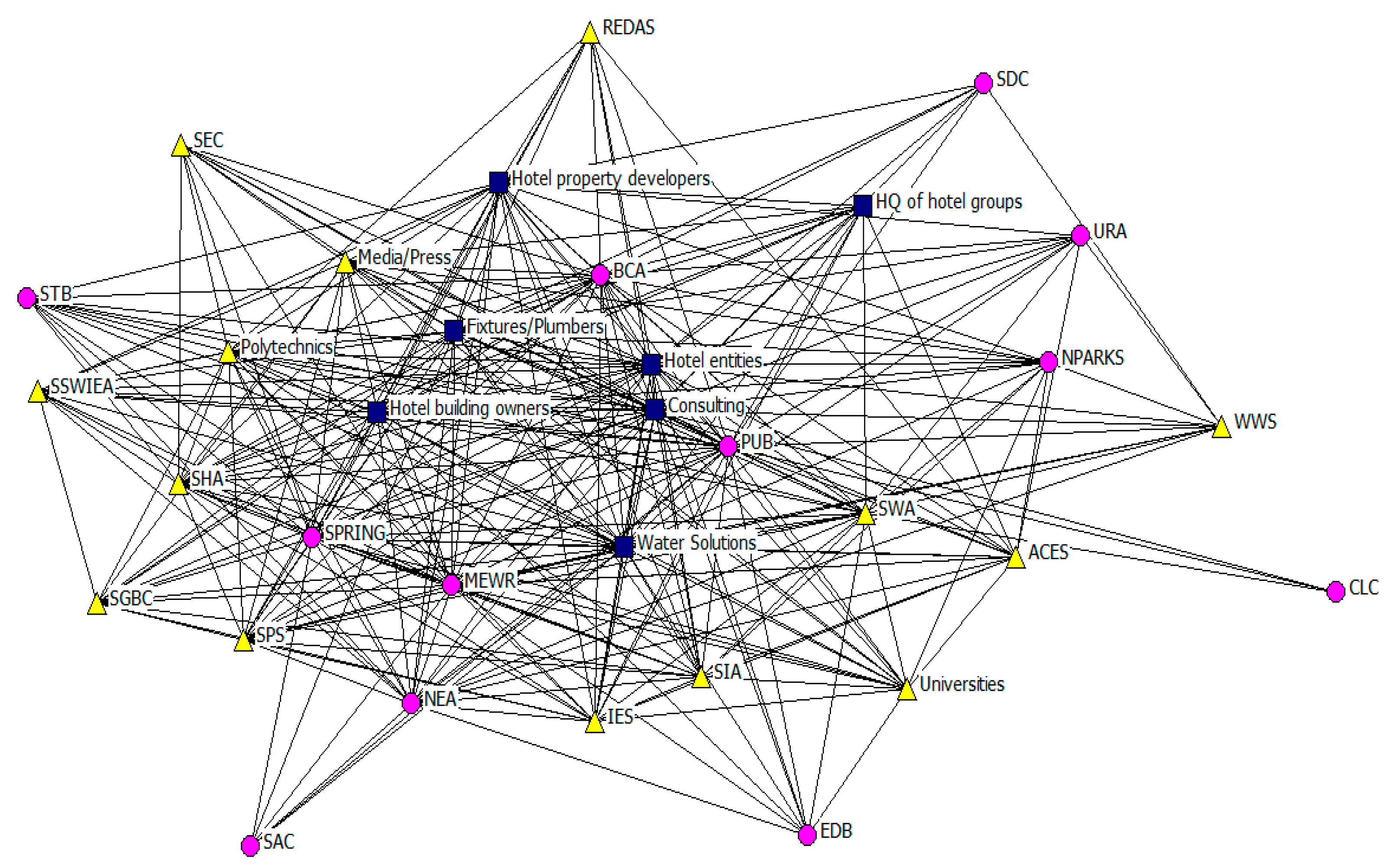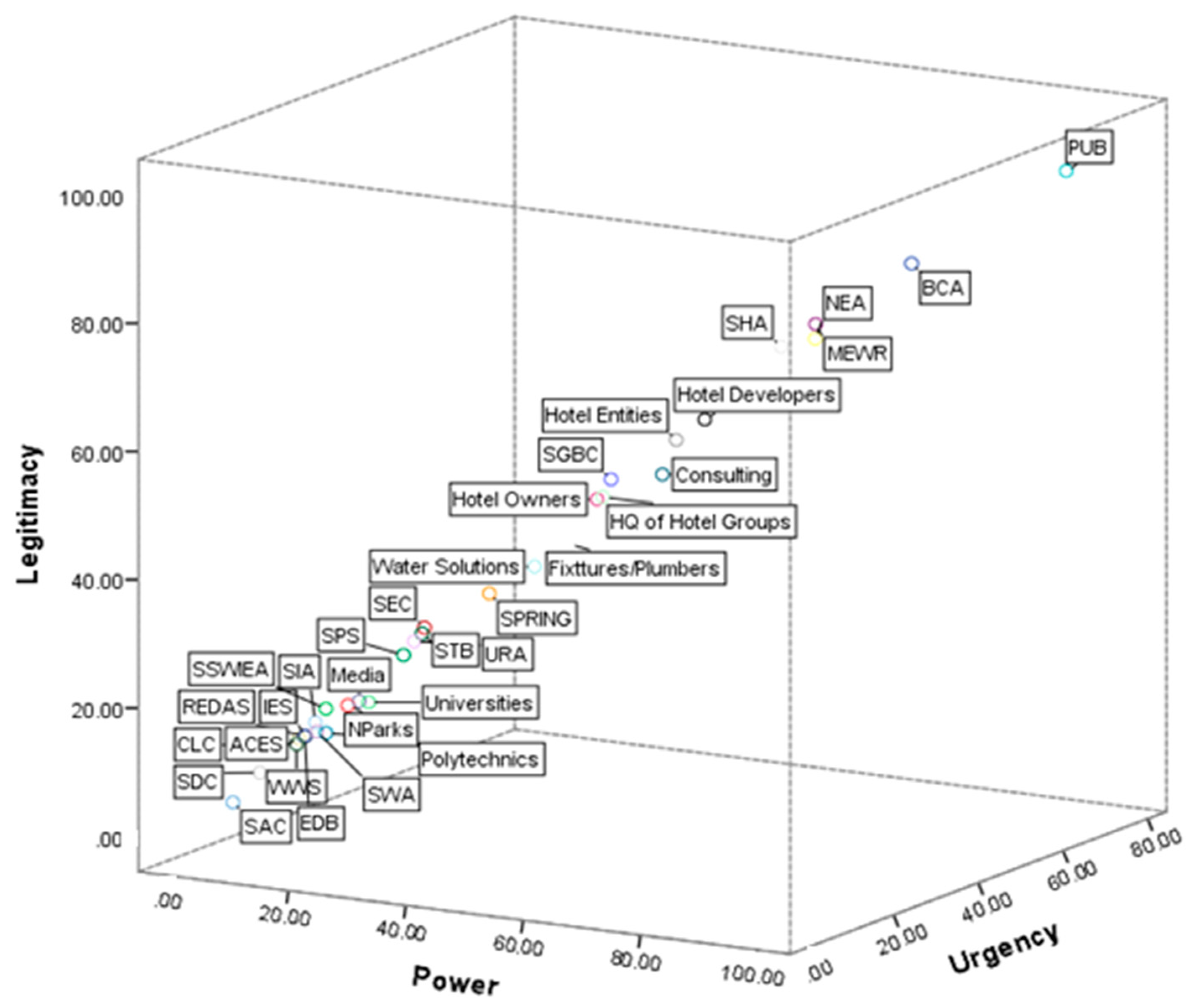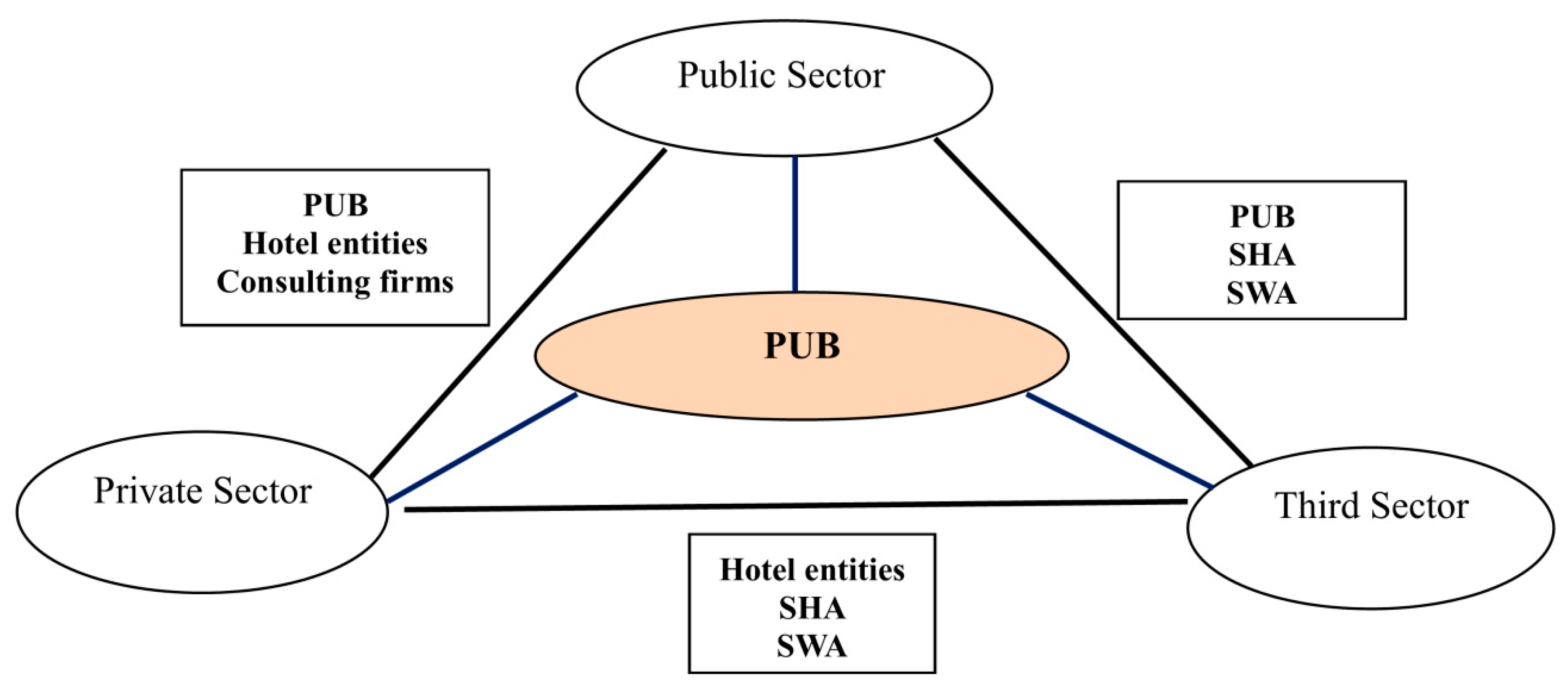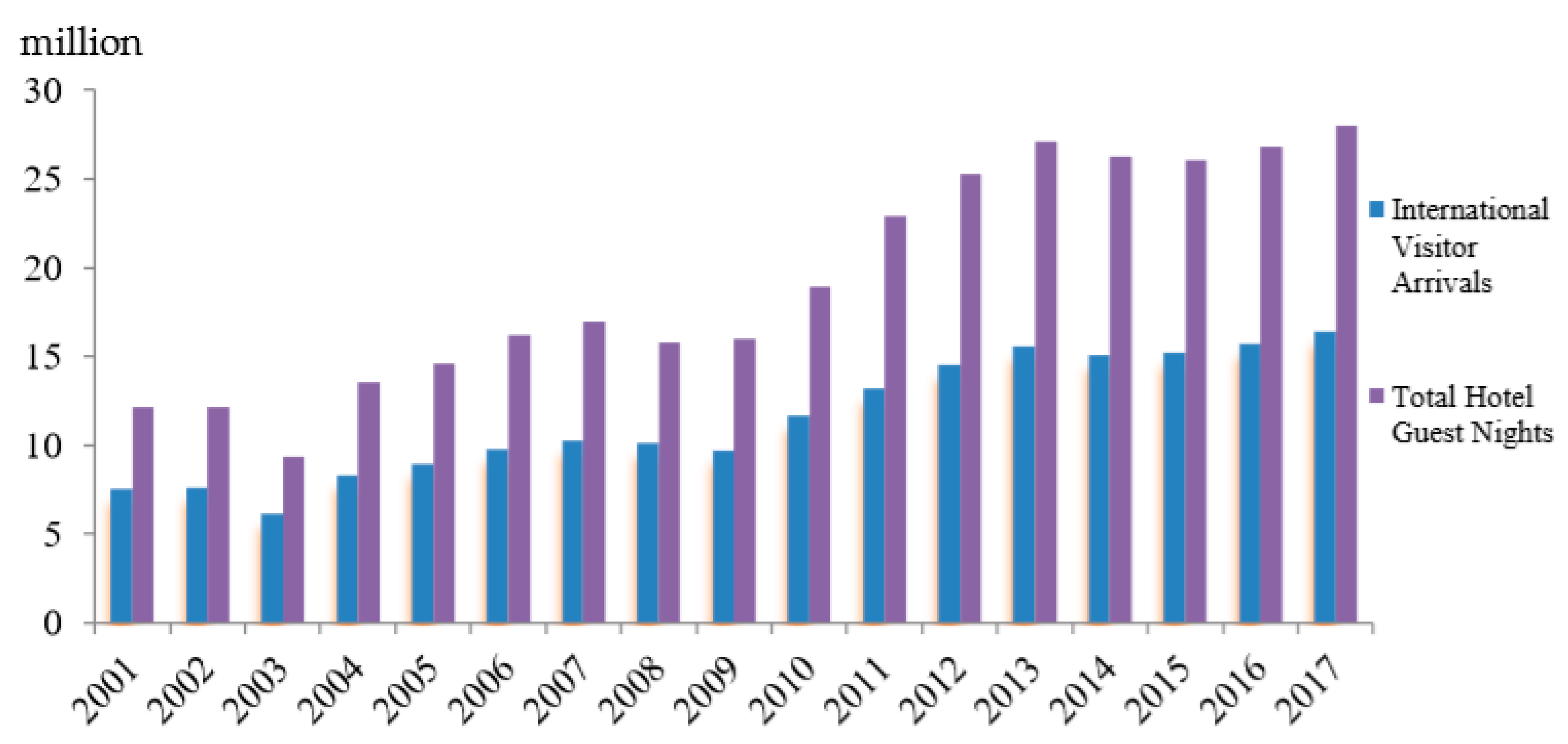Stakeholder Collaboration on Policymaking for Sustainable Water Management in Singapore’s Hotel Sector: A Network Analysis
Abstract
:1. Introduction
2. Water Policy Research in the Tourism Industry
3. Methods
3.1. Study Area: Singapore as Case
3.2. Data Collection and Analysis
3.2.1. Name Generation
Which organisation(s) located in Singapore do you think have either an actual or potential effect on policy formulation and implementation of water demand management (WDM) in Singapore’s hotel sector? Please list as many names as you can recall.
3.2.2. Survey Questionnaire Development and Administration
- -
- Which stakeholder(s) on this list should be involved in policy formulation and implementation of WDM in Singapore’s hotel sector? Using the scale, please circle the relevant degree of acceptability of for each of the following stakeholders.
- -
- How much power (i.e., problem solving capacity) do the stakeholders below exercise over others with regard to policy formulation and implementation of WDM in Singapore’s hotel sector? Using the scale, please circle the relevant degree of problem solving capacity of for each of the following stakeholders.
- -
- With regard to policy formulation and implementation of WDM in Singapore’s hotel sector, claim from some stakeholders might be considered to be trustworthy. Using the scale, please circle the relevant degree of trustworthiness of for each of the following stakeholders.
4. Results
4.1. Policy Stakeholder Network Visualisation
4.2. Underlying Structure of Policy Stakeholder Network
4.3. Stakeholder Salience
5. Discussion
6. Conclusions
Author Contributions
Funding
Acknowledgments
Conflicts of Interest
References
- Edgell, D.L.; Swanson, J.R. Tourism Policy and Planning: Yesterday, Today, and Tomorrow, 2nd ed.; Routledge: Abingdon, UK; New York, NY, USA, 2013. [Google Scholar]
- Mason, P. Tourism Impacts, Planning and Management, 3rd ed.; Routledge: London, UK; New York, NY, USA, 2016. [Google Scholar]
- Buckley, R.; Pickering, C.; Weaver, D.B. Nature-Based Tourism, Environment, and Land Management; CABI Publishing: Wallingford, UK, 2003. [Google Scholar]
- Hall, C.M. Tourism and Social Marketing; Taylor and Francis: New York, NY, USA, 2014. [Google Scholar]
- Pierre, J.; Peters, B.G. Governance, Politics, and the State; St. Martin’s Press: New York, NY, USA, 2000. [Google Scholar]
- Rezaee, Z.; Choi, E.K. The Relevance of Business Sustainability in the Hotel Industry. In Sustainability in Hospitality: How Innovative Hotels Are Transforming the Industry; Gardetti, M.A., Torres, A.L., Eds.; Greenleaf Publishing: Sheffield, UK, 2016; pp. 25–40. [Google Scholar]
- Gössling, S.; Hall, C.M.; Scott, D. Tourism and Water; Channel View Publications: Bristol, UK, 2015. [Google Scholar]
- World Tourism Organisation. 2017 International Tourism Results: The Highest in Seven Years. Available online: http://media.unwto.org/press-release/2018-01-15/2017-international-tourism-results-highest-seven-years (accessed on 4 August 2018).
- Hawkins, R.; Bohdanowicz, P. Responsible Hospitality: Theory and Practice; Goodfellow: Oxford, UK, 2012. [Google Scholar]
- World Tourism Organisation. Indicators of Sustainable Development for Tourism Destinations: A Guidebook; The World Tourism Organisation: Madrid, Spain, 2004. [Google Scholar]
- DeyàTortella, B.; Tirado, D. Hotel water consumption at a seasonal mass tourist destination. The case of the island of Mallorca. J. Environ. Manag. 2011, 92, 2568–2579. [Google Scholar]
- Hotel Energy Solutions. About Us. Available online: http://hotelenergysolutions.net/content/about-us-6 (accessed on 17 August 2018).
- Hadjikakou, M.; Chenoweth, J.; Miller, G. Estimating the direct and indirect water use of tourism in the eastern Mediterranean. J. Environ. Manag. 2013, 114, 548–556. [Google Scholar] [CrossRef]
- Becken, S.; Dolnicar, S. Uptake of resource efficiency measures among European small and medium-sized accommodation and food service providers. J. Hosp. Tour. Manag. 2016, 26, 45–49. [Google Scholar] [CrossRef]
- Crase, L.; O’Keefe, S. (Eds.) Water Policy, Tourism, and Recreation: Lessons from Australia; RFF Press: Abingdon, UK; New York, NY, USA, 2011. [Google Scholar]
- Gössling, S. New performance indicators for water management in tourism. Tour. Manag. 2015, 46, 233–244. [Google Scholar] [CrossRef]
- Hadjikakou, M.; Miller, G.; Chenoweth, J.; Druckman, A.; Zoumides, C. A comprehensive framework for comparing water use intensity across different tourist types. J. Sustain. Tour. 2015, 23, 1445–1467. [Google Scholar] [CrossRef]
- Kasim, A.; Gursoy, D.; Okumus, F.; Wong, A. The importance of water management in hotels: A framework for sustainability through innovation. J. Sustain. Tour. 2014, 22, 1090–1107. [Google Scholar] [CrossRef]
- Gunther, M. Water as a Natural Resource—The Blue Planet. Available online: http://wwf.panda.org/about_our_earth/teacher_resources/webfieldtrips/water/ (accessed on 3 August 2018).
- Gill, A.; Williams, P.; Thompson, S. Perceived Water Conservation Attitudes and Behaviours in Second-Home Island Settings. Tour. Hosp. Res. 2010, 10, 141–151. [Google Scholar] [CrossRef]
- Gössling, S.; Peeters, P.; Hall, C.M.; Ceron, J.P.; Dubois, G.; Scott, D. Tourism and water use: Supply, demand, and security. an international review. Tour. Manag. 2012, 33, 1–15. [Google Scholar] [CrossRef]
- Butler, D.; Memon, F.A. Water Demand Management; IWA Publishing: London, UK; Seattle, WA, USA, 2005. [Google Scholar]
- Araral, E.; Wang, Y. Water demand management: Review of literature and comparison in South-East Asia. Int. J. Water Resour. Dev. 2013, 29, 434–450. [Google Scholar] [CrossRef]
- Afonso, A.S.; Rodrigues, C.P. Water Policy for Buildings. In Water Efficiency in Buildings: Theory and Practice; Adeyeye, K., Ed.; John Wiley & Sons Ltd.: Chichester, UK, 2014; pp. 42–56. [Google Scholar]
- Byrd, E.T. Stakeholders in sustainable tourism development and their roles: Applying stakeholder theory to sustainable tourism development. Tour. Rev. 2007, 62, 6–13. [Google Scholar] [CrossRef]
- Haywood, K.M. Responsible and responsive tourism planning in the community. Tour. Manag. 1988, 9, 105–118. [Google Scholar] [CrossRef]
- Jamal, T.B.; Getz, D. Collaboration theory and community tourism planning. Ann. Tour. Res. 1995, 22, 186–204. [Google Scholar] [CrossRef]
- Presenza, A.; Cipollina, M. Analysing tourism stakeholders networks. Tour. Rev. 2010, 65, 17–30. [Google Scholar] [CrossRef]
- Prell, C.; Hubacek, K.; Reed, M. Stakeholder analysis and social network analysis in natural resource management. Soc. Nat. Resour. 2009, 22, 501–518. [Google Scholar] [CrossRef]
- Lienert, J.; Schnetzer, F.; Ingold, K. Stakeholder analysis combined with social network analysis provides fine-grained insights into water infrastructure planning processes. J. Environ. Manag. 2013, 125, 134–148. [Google Scholar] [CrossRef] [PubMed]
- Scott, J. Social Network Analysis: A Handbook, 3rd ed.; Sage Publications Ltd.: London, UK, 2013. [Google Scholar]
- Burt, R.S. Structural Holes: The Social Structure of Competition; Harvard University Press: Cambridge, MA, USA, 2013. [Google Scholar]
- Robins, G. Doing Social Network Research: Network-Based Research Design for Social Scientists; Sage Publications Ltd.: Los Angeles, CA, USA, 2015. [Google Scholar]
- Dredge, D. Policy networks and the local organisation of tourism. Tour. Manag. 2006, 27, 269–280. [Google Scholar] [CrossRef]
- Timur, S.; Getz, D. A network perspective on managing stakeholders for sustainable urban tourism. Int. J. Contemp. Hosp. Manag. 2008, 20, 445–461. [Google Scholar] [CrossRef]
- Bhullar, L. Climate change adaptation and water policy: Lessons from Singapore. Sustain. Dev. 2013, 21, 152–159. [Google Scholar] [CrossRef]
- Meteorological Service Singapore. Climate of Singapore. Available online: http://www.weather.gov.sg/climate-climate-of-singapore/ (accessed on 20 January 2019).
- Food and Agriculture Organisation of the United Nations. Average Precipitation in Depth (mm per year); The World Bank Group: Washington, DC, USA, 2018. [Google Scholar]
- Tortajada, C.; Joshi, Y.; Biswas, A.K. The Singapore Water Story: Sustainable Development in an Urban City-State; Routledge: London, UK, 2013. [Google Scholar]
- Luan, I.O.B. Singapore water management policies and practices. Int. J. Water Resour. Dev. 2010, 26, 65–80. [Google Scholar] [CrossRef]
- Black, M. Atlas of Water: Mapping the World’s Most Critical Resource, 3rd ed.; University of California Press: Oakland, CA, USA, 2016. [Google Scholar]
- Department of Statistics Singapore. Yearbook of Statistics Singapore; Department of Statistics Singapore, Ministry of Trade & Industry: Singapore, 2018.
- Henderson, J.C.; Foo, K.; Lim, H.; Yip, S. Sports events and tourism: The Singapore Formula One Grand Prix. Int. J. Event Festiv. Manag. 2010, 1, 60–73. [Google Scholar] [CrossRef]
- Chung, L.H.; Parker, L.D. Managing social and environmental action and accountability in the hospitality industry: A Singapore perspective. Account. Forum 2010, 34, 46–53. [Google Scholar] [CrossRef]
- Woods, R. Short-Term Forecasts of Visitor Arrivals to Singapore, 2018–2020. Available online: http://hotelinvestmentstrategies.com/short-term-forecasts-of-visitor-arrivals-to-singapore-2018-2020/ (accessed on 25 February 2019).
- Singapore Tourism Board. The Annual Report on Tourism Statistics 2001; Singapore Tourism Board: Singapore, 2002.
- Singapore Tourism Board. The Annual Report on Tourism Statistics 2007; Singapore Tourism Board: Singapore, 2008.
- Singapore Tourism Board. The Annual Report on Tourism Statistics 2016; Singapore Tourism Board: Singapore, 2018.
- Singapore Tourism Board. International Visitor Arrivals Statistics 2017; Singapore Tourism Board: Singapore, 2018.
- Gössling, S. Tourism and Water: Interrelationships and Management. Available online: http://www.globalwaterforum.org/2013/07/16/tourism-and-water-interrelationships-and-management/ (accessed on 11 October 2017).
- Becken, S. Water equity—Contrasting tourism water use with that of the local community. Water Resour. Ind. 2014, 7–8, 9–22. [Google Scholar] [CrossRef]
- Pacific Asia Travel Association. The Connected Visitor Economy—Water and Tourism; Pacific Asia Travel Association: Bangkok, Thailand, 2015. [Google Scholar]
- Tan, C.K. Chapter IX: Singapore. In Good Practices in Urban Water Management: Decoding Good Practices for a Successful Future; Chiplunkar, A., Seetharam, K., Tan, C.K., Eds.; Asian Development Bank: Manila, Philippines; Singapore, 2012; pp. 265–308. [Google Scholar]
- Public Utilities Board. Singapore Water Story. Available online: https://www.pub.gov.sg/watersupply/singaporewaterstory (accessed on 21 October 2018).
- Lidé, S. Water Management Strategy (Singapore). In Delivering Sustainable Competitiveness: Revisiting the Organising Capacity of Cities; Carvalho, L., Berg, L.V.D., Galal, H., Teunisse, P., Eds.; Routledge: London, UK; New York, NY, USA, 2017; pp. 184–199. [Google Scholar]
- Bogason, P.; Zølner, M. Methods for network governance research: An introduction. In Methods in Democratic Network Governance; Bogason, P., Zølner, M., Eds.; Palgrave Macmillan: Basingstoke, UK, 2007; pp. 1–20. [Google Scholar]
- Pforr, C. Tourism Governance and the Influence of Stakeholder Networks—A Case Study from Western Australia. In Tourism and Leisure: Current Issues and Perspectives of Development; Pechlaner, H., Smeral, E., Eds.; Springer Fachmedien Wiesbaden: Wiesbaden, Germany, 2015; pp. 145–160. [Google Scholar]
- Melbeck, C. Comparing local policy networks. J. Theor. Polit. 1998, 10, 531–552. [Google Scholar] [CrossRef]
- Prell, C. Social Network Analysis: History, Theory and Methodology; Sage Publications Ltd.: Los Angeles, CA, USA; London, UK, 2012. [Google Scholar]
- Bryman, A. Of methods and methodology. Qualit. Res. Organ. Manag. Int. J. 2008, 3, 159–168. [Google Scholar] [CrossRef]
- Singapore Hotel Association. SHA Update. In The SHA Hotel Members; Singapore Hotel Association: Singapore, 2017. [Google Scholar]
- Mitchell, R.K.; Agle, B.R.; Wood, D.J. Toward a theory of stakeholder identification and salience: Defining the principle of who and what really counts. Acad. Manag. Rev. 1997, 22, 853–886. [Google Scholar] [CrossRef]
- Ahmed, E. Organisational social responsibility in tourism: The role of firm-stakeholder networks. In School of Marketing; The University of New South Wales: Sydney, Australia, 2012. [Google Scholar]
- Timur, S. A network perspective of stakeholder relationships in the context of sustainable urban tourism. In Haskayne School of Business; University of Calgary: Calgary, AB, Canada, 2005. [Google Scholar]
- Wang, S. Making Sustainable Rural Tourism Policies from a Social Network Perspective; Shandong University Press: Ji’nan, China, 2011. [Google Scholar]
- Nastran, M. Stakeholder analysis in a protected natural park: Case study from Slovenia. J. Environ. Plan. Manag. 2014, 57, 1359–1380. [Google Scholar] [CrossRef]
- Pforr, C. Tourism Public Policy in the Northern Territory of Australia: A Policy Study of the First Northern Territory Tourism Development Masterplan; LAP Lambert Academic Publishing: Saarbrücken, Germany, 2013. [Google Scholar]
- Racherla, P.; Hu, C. A social network perspective of tourism research collaborations. Ann. Tour. Res. 2010, 37, 1012–1034. [Google Scholar] [CrossRef]
- Borgatti, S.P.; Everett, M.G.; Johnson, J.C. Analyzing Social Networks; Sage Publications Ltd.: Los Angeles, CA, USA; London, UK, 2013. [Google Scholar]
- Costenbader, E.; Valente, T.W. The stability of centrality measures when networks are sampled. Soc. Netw. 2003, 25, 283–307. [Google Scholar] [CrossRef]
- Freeman, L.C. Centrality in social networks conceptual clarification. Soc. Netw. 1978, 1, 215–239. [Google Scholar] [CrossRef]
- De Nooy, W.; Mrvar, A.; Batagelj, V. Exploratory Social Network Analysis with Pajek; Cambridge University Press: Cambridge, MA, USA, 2011. [Google Scholar]
- Casanueva, C.; Gallego, Á.; García-Sánchez, M.-R. Social network analysis in tourism. Curr. Iss. Tour. 2016, 19, 1190–1209. [Google Scholar] [CrossRef]
- Lazega, E.; Snijders, T.A.B. Multilevel Network Analysis for the Social Sciences: Theory, Methods and Applications; Springer International Publishing AG.: Cham, Germany, 2016. [Google Scholar]
- Dredge, D.; Jenkins, J.M. Tourism Planning and Policy; John Wiley & Sons Australia: Milton, Australia, 2007. [Google Scholar]
- Reig, P.; Maddocks, A.; Gassert, F. World’s 36 Most water-Stressed Countries. Available online: https://www.wri.org/blog/2013/12/world-s-36-most-water-stressed-countries (accessed on 3 May 2018).
- Orr, S.K. Environmental Policymaking and Stakeholder Collaboration Theory and Practice; CRC Press: Baton Rouge, LA, USA, 2013. [Google Scholar]
- Tan, Y.S.; Kwek, L.J. Environmental sustainability and sustainable development. In Fifty Years of Environment, Singapore’s Journey Towards Environmental Sustainability; Tan, Y.S., Ed.; World Scientific: Singapore, 2016. [Google Scholar]
- Hall, C.M. Tourism Planning: Policies, Processes and Relationships, 2nd ed.; Prentice Hall: New York, NY, USA; Harlow, UK, 2008. [Google Scholar]
- Lemos, M.C.; Agrawal, A. Environmental governance and political science. In Governance for the Environment: New Perspectives; Delmas, M.A., Young, O.R., Eds.; Cambridge University Press: Cambridge, MA, USA, 2009; pp. 69–97. [Google Scholar]
- Thompson, G.; Pforr, C. Policy Networks and Good Governance: A Discussion; Curtin University of Technology: Perth, Australia, 2005. [Google Scholar]
- Jenkins, I.; Schröder, R. Sustainability in Tourism: A Multidisciplinary Approach; Springer Gabler: Wiesbaden, Germany, 2013. [Google Scholar]

 Public Sector;
Public Sector;  Private Sector;
Private Sector;  Third Sector.
Third Sector.
 Public Sector;
Public Sector;  Private Sector;
Private Sector;  Third Sector.
Third Sector.


| Stakeholder | Acronym |
|---|---|
| Public Sector | |
| Building and Construction Authority | BCA |
| Centre for Liveable Cities | CLC |
| Economic Development Board | EDB |
| Ministry of the Environment and Water Resources | MEWR |
| National Environment Agency | NEA |
| National Parks Board | NParks |
| Public Utilities Board | PUB |
| Sentosa Development Corporation | SDC |
| Singapore Accreditation Council | SAC |
| Singapore Tourism Board | STB |
| Standards, Productivity and Innovation Board | SPRING |
| Urban Redevelopment Authority | URA |
| Private Sector | |
| Consulting and advisory service providers | Consulting |
| Corporate headquarter/Parent company of hotels | HQ oh hotel groups |
| Hotel building owners/equity investors | Hotel building owners |
| Hotel entities | Hotel entities |
| Hotel property developers/Architects/Builders | Hotel property developers |
| Water service companies/Water solutions | Water solutions |
| Water-wise fixture suppliers/Plumbers | Fixtures/Plumbers |
| Third Sector | |
| Media/Press | Media/Press |
| Universities (in Singapore) | Universities |
| Institution of Engineers Singapore | IES |
| Singapore Institute of Architects | SIA |
| Singapore Environment Council | SEC |
| Singapore Green Building Council | SGBC |
| Singapore Hotel Association | SHA |
| Polytechnics (in Singapore) | Polytechnics |
| Singapore Water Association | SWA |
| Waterways Watch Society | WWS |
| Singapore Plumbing Society | SPS |
| Real Estate Developers’ Association of Singapore | REDAS |
| Singapore Sanitary Ware Importers and Exporters Association | SSWIEA |
| Association of Consulting Engineers, Singapore | ACES |
| Rank | Stakeholders | In-Degree Centrality | Normalised In-Degree Centrality (%) | Stakeholders | Density (%) |
|---|---|---|---|---|---|
| 1 | Consulting | 31 | 96.88 | CLC | 100 |
| 2 | PUB | 30 | 93.75 | SAC | 100 |
| 3 | Hotel entities | 30 | 93.75 | SEC | 97.78 |
| 4 | Water solutions | 28 | 87.50 | EDB | 97.22 |
| 5 | BCA | 26 | 81.25 | STB | 96.97 |
| 6 | Fixtures/Plumbers | 26 | 81.25 | SSWIEA | 91.43 |
| 7 | MEWR | 25 | 78.13 | SPS | 89.54 |
| 8 | SPRING | 24 | 75.00 | REDAS | 88.89 |
| 9 | Hotel building owners | 23 | 71.88 | HQ of hotel groups | 87.18 |
| 10 | Hotel property developers | 23 | 71.88 | SDC | 85.71 |
| 11 | SWA | 23 | 71.88 | URA | 84.44 |
| 12 | NEA | 21 | 65.63 | SGBC | 83.52 |
| 13 | SHA | 21 | 65.63 | SIA | 81.87 |
| 14 | Polytechnics | 21 | 65.63 | IES | 81.70 |
| 15 | Media/Press | 19 | 59.38 | Universities | 80.00 |
| 16 | SIA | 19 | 59.38 | SHA | 78.57 |
| 17 | IES | 18 | 56.25 | NPARKS | 78.21 |
| 18 | SPS | 18 | 56.25 | Polytechnics | 78.10 |
| 19 | Universities | 16 | 50.00 | Media/Press | 77.78 |
| 20 | ACES | 16 | 50.00 | WWS | 73.33 |
| 21 | SSWIEA | 15 | 46.88 | Hotel building owners | 70.75 |
| 22 | SGBC | 14 | 43.75 | NEA | 70.00 |
| 23 | NPARKS | 13 | 40.63 | SPRING | 68.84 |
| 24 | HQ of hotel groups | 13 | 40.63 | Hotel property developers | 67.98 |
| 25 | STB | 12 | 37.50 | ACES | 67.50 |
| 26 | URA | 10 | 31.25 | MEWR | 66.67 |
| 27 | SEC | 10 | 31.25 | SWA | 66.01 |
| 28 | WWS | 10 | 31.25 | BCA | 64.00 |
| 29 | REDAS | 10 | 31.25 | Water solutions | 62.69 |
| 30 | EDB | 9 | 28.13 | Fixtures/Plumbers | 62.15 |
| 31 | SDC | 7 | 21.88 | Hotel entities | 58.85 |
| 32 | SAC | 6 | 18.75 | Consulting | 55.48 |
| 33 | CLC | 3 | 9.38 | PUB | 54.71 |
© 2019 by the authors. Licensee MDPI, Basel, Switzerland. This article is an open access article distributed under the terms and conditions of the Creative Commons Attribution (CC BY) license (http://creativecommons.org/licenses/by/4.0/).
Share and Cite
Hu, X.; Lovelock, B.; Ying, T.; Mager, S. Stakeholder Collaboration on Policymaking for Sustainable Water Management in Singapore’s Hotel Sector: A Network Analysis. Sustainability 2019, 11, 2360. https://doi.org/10.3390/su11082360
Hu X, Lovelock B, Ying T, Mager S. Stakeholder Collaboration on Policymaking for Sustainable Water Management in Singapore’s Hotel Sector: A Network Analysis. Sustainability. 2019; 11(8):2360. https://doi.org/10.3390/su11082360
Chicago/Turabian StyleHu, Xiao, Brent Lovelock, Tianyu Ying, and Sarah Mager. 2019. "Stakeholder Collaboration on Policymaking for Sustainable Water Management in Singapore’s Hotel Sector: A Network Analysis" Sustainability 11, no. 8: 2360. https://doi.org/10.3390/su11082360
APA StyleHu, X., Lovelock, B., Ying, T., & Mager, S. (2019). Stakeholder Collaboration on Policymaking for Sustainable Water Management in Singapore’s Hotel Sector: A Network Analysis. Sustainability, 11(8), 2360. https://doi.org/10.3390/su11082360







